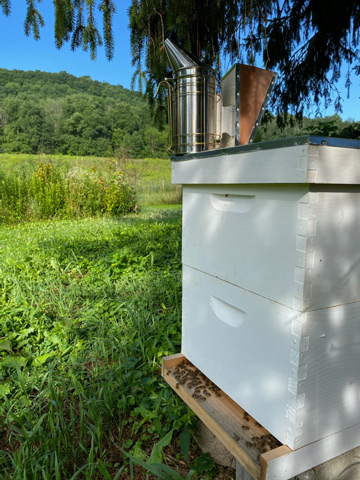
How to Choose Your Bee Hive Location
As a beginning beekeeper, the location of your bee hive is one of the most important decisions you’ll make. Hive placement is mainly a consideration for the beekeeper and other humans, but choosing wisely will also help the bees.
Scope out the flight path when selecting a bee hive location
A honey bee’s flight path is a straight, rising flightline up and out from the hive. Pick a spot that is clear 10 to 15 feet in front of your hives, to give your bees a good flight path.
Avoid pointing your hive’s exit in the direction of a neighbor’s yard, street traffic, the entrance to your home, or even a doghouse — unless you have a hedgerow or fence to force the bees higher into the air as they take off. Such a barrier ensures the flight path goes up and over the heads of people.
Consider proximity to your house
Even if you live out in the country, place the hive in a spot where you can at least glance at it daily. A fallen tree, bear, or wind could knock a hive cover off - or tip a hive over. Avoid the temptation to set up hives out of sight at the far edge of your hayfield.
The best place to put your hives is in an area that’s easy for you to access. At some point, heavy honey will be moved from the hives to your house. Will that be done using a truck, car, wheelbarrow?
It’s good to have room to work at a hive without feeling crowded. If the hive is by a wall or hedgerow, allow two to three feet on all sides. This gives you space to set equipment down as you work, and easily maneuver. For garden locations, design in some clear working space around the hive.
Commit to a location
Moving bee hives is possible, but can be tricky to do. Foraging worker bees have learned their hive location, and will try to return to it if the hive is moved elsewhere. If a hive absolutely must be moved, you can either move it only a couple of feet per day to its new location, or else move it multiple miles away for a few weeks before it moves to its final location at the original property. To avoid this future hassle of moving your hives around, make sure you’ve chosen a good hive location from the get-go.
Pick a bee hive location with both sun and shade
Try to avoid extremes of sun and shade. A partly shaded area gives you the benefit of bright sunshine to see deeply into cells during inspections, but also provides you the beekeeper with some shade while working on a hot day. Likewise, don’t set up bee hives in the woods where shade makes inspections difficult, and the dampness may encourage the fungal disease Chalkbrood.
Consider unique bee hive placement in urban areas
Urban beekeeping has become more popular in recent years. If you live in a city or residential area, see if it’s legal to keep bees at your home or apartment. Then pick a location for your bee hives that follows the same guidelines as a rural apiary. If you lack space on the ground around your home, rooftop beekeeping may be an option. Or perhaps a community garden offers space for beekeepers.
Safety tip: Avoid keeping bee hives on the rooftop if the only access is via a fire escape, ladder, or rooftop hatch. It’s cumbersome to move heavy equipment through these tricky pathways. And picture a misstep after a surprising sting!
Quick tips for setting up backyard bee hives
In the country or the city, resourceful honey bees will find a way to get what they need. When it comes to picking the ideal spot to place your hives, follow these basic guidelines — and if your property doesn’t include these conditions naturally, get creative!
- Bees need water. Typically, bees will drink at the edge of a ditch, pond, puddle, or quiet stretch of a stream. Being efficient, they’ll access the closest source, so if a swimming pool is closer than a pond, they’ll choose the pool.
- Set up your bee hives near a natural windbreak, like a hedgerow, to keep cold winds from stressing the colony. If none exists, create a windbreak with a hedge or fence.
- Elevate your hives at least 12 inches to discourage skunks, and defend your hive equipment from moisture. This also puts less stress on your back. Don’t start too high though. Hives get taller as honey boxes are added!
- Elevate your hives to keep ground moisture away from your bees. Use a hive stand to give them a lift. This also puts less stress on your back as you check your hives each day.
- Bee hives can attract nuisance animals including bears. If you have bees in bear country, starting with an electric fence is better than adding one after a bear finds your hives.
What about nectar and pollen sources?
The bees are very resourceful searching for food. The fields, forests and roadsides are plentiful sources of wildflowers, bushes, and tree blossoms. Country properties with pastures and deciduous woods are best for bee forage. Bees fly the shortest distance needed to find nectar and pollen, but will go out in all directions from the hive up to 2 miles or so if necessary.
You may have noticed that many of our bee hive location suggestions relate to humans, and only a few relate to actual bees. These human-centered details will make it more likely that you’ll pay attention to your bees and enjoy caring for them, which will then increase the likelihood that you’ll become a good beekeeper.
Ready for more beekeeping knowledge? Attend a few beekeeping classes or workshops to learn more about honey bee management.

